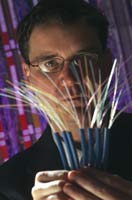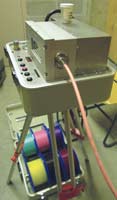Responding to Tomorrow's Technology
- By Brian A. Young
- 06/04/04
 Creighton is among the first academic institutions in the nation to implement
Blolite, an optical fiber system into residence halls—utilizing the maximum
density of 12 Blolite fiber optic cables per tube.
Creighton is among the first academic institutions in the nation to implement
Blolite, an optical fiber system into residence halls—utilizing the maximum
density of 12 Blolite fiber optic cables per tube.
A Forward-Thinking Approach
The concept of a blown optical fiber system involves installing a network of
empty tubes, called Microduct. Fiber optic cable is then easily blown into the
tubes as required by immediate or future network demands. Driven by the need
to remain technologically competitive while challenged with IT funding, schools
and universities, especially, benefit from the extraordinary design flexibility
and “pay-as-you-grow” features of blown optical fiber networks.
When Rick Brokofsky, director of telecommunications at Creighton University
encountered General Cable/NextGen Fiber Optics’ Blolite blown optical
fiber system (www.blolite.net), he was
captivated by the technology and what it could mean for Creighton University.
In a Blolite system, sections of Microduct tubes are joined together with push-fit
connectors and installed throughout the campus to extend pathways to each network
destination. Once the tubes are in place, a two-person crew uses specialized
equipment that delivers compressed air to propel up to 12 optical fibers through
each tube. Only the amount of fiber required by the network at the initial installation
is blown into the tubes while spare tubes remain empty to accommodate future
fiber installations.
Although fiscal limitations can often impede initial spending, a network infrastructure
should be considered a long-term investment designed to support future network
requirements. Because the information-carrying capacity of fiber optic cabling
is essentially infinite, a blown optical fiber system will support Creighton
for several decades. “For maximum cost effectiveness as we remodel or
build new campus buildings, we have to strive to make them technologically sound
for a minimum of 30 years,” says Brokofsky.
The built-in adaptability and capacity of a blown optical fiber infrastructure
provides complete design control now and in the future, ensuring maximum bandwidth
for the highest value with the lowest possible risk. This gives Creighton a
competitive advantage. Because the rate of technological change is increasing
and network capacity is essential to enhanced learning, teaching, and campus
communication, a flexible network design that allows for virtually unlimited
growth in a simple, cost-effective manner is key to Creighton’s future.

Figure 1: Compressed air is delivered to propel up to 12 optical fibers through each Microduct
tube.
An Ideal Infrastructure
Using blown optical fiber technology, Creighton University is currently upgrading
its network infrastructure to a true star configuration, with the center of
the star located in the lower level of the Reinert/Alumni Memorial Library,
in the heart of the main campus.
When campus expansion called for the construction of the new Hixson-Lied Science
Building, Brokofsky specified the Blolite blown optical fiber system to connect
the new building to the campus network. Creighton University’s recently
renovated Rigge Science Center and Criss Medical School are also connected to
the network via several spare and populated tubes and nearly 70,000 feet of
Blolite fiber.
Following completion of the new science complex, Creighton University adopted
a new network standard of at least one Microduct tube for every room. “At
least one outlet in every classroom, office, and laboratory will have a spare
tube for future fiber connectivity,” says Brokofsky. “Our minimum
standard to the renovated residence life areas consists of three Category 6
cables, one coaxial connection for CATV, and one Microduct tube.”
Creighton University is one of the first educational institutions to bring
blown optical fiber into residence halls to ensure that students continue to
have 24/7 access to the latest technology in all areas of the campus. Three
new multi-bedroom residence halls for junior and senior students are connected
to the network with blown fiber and include one empty tube to every “pillow”
as part of the new standard.
A Future Cost Advantage
Information technology improves and strengthens all aspects of the academic
environment. As computing applications become central to student life, enhanced
teaching, better research, and improved administration operations, all members
of the university will continually require improved technology, network uptime,
and increased bandwidth. Therefore, the process of planning a campus network
requires participation of all stakeholders and a funding strategy that covers
continual network growth. A blown fiber system is a financially strategic approach
that provides built-in network capacity.
Future network requirements can be difficult to determine, and Brokofsky admits
that choosing a blown fiber system has put an end to the uncertainty of how
many and what types of fiber to install. By allowing the university to install
only the fiber needed today and easily add fiber to spare tubes in the future,
blown fiber eliminates the cost, time, and guesswork associated with future
proofing by installing dark (unused) fiber.
Because technology is rapidly evolving and academic environments like Creighton
are prone to frequent moves, adds, and changes (MACs), the ideal campus network
should easily accommodate modifications and the replacement of obsolete technology
with as little downtime as possible. With a blown fiber system, the existing
infrastructure of tube pathways is already in place, which means minimal disruption
to the physical environment of the campus during MACs. “Adding additional
blown fiber requires much less labor cost than installing conventional fiber
optic cable and allows us to get the network up and running that much faster.
It’s not at all disruptive to our campus life,” says Brokofsky.
In a Blolite optical fiber system, obsolete fiber can be easily blown out of
populated tubes and new fiber blown back into empty tubes when network requirements
have changed.
This saves on the labor costs associated with removing the obsolete
fiber. While blowing a maximum of eight fibers per-tube was common practice
at the time of the initial installation, Brokofsky had 12 Blolite fibers blown
into populated tubes for maximum cost effectiveness. Creighton University is
the first academic facility in the United States to blow all 12 Blolite fibers
into the Microduct tubes, the highest fiber density available.
A Concept to Grow On
Moving forward, Creighton University plans to deploy the Blolite blown optical
fiber system for its entire data network. Plenty of spare Microduct tubes will
provide a way to easily expand the campus network, positioning the university
for success in the 21st century and ensuring that students have access to nationwide
and worldwide information and resources. An upcoming eastward expansion of the
campus will include 28 Microduct tubes and over 250,000 feet of Blolite fiber
for several buildings, including a new soccer arena.
Creighton University programs in medicine and dentistry involve research-based
application access to remote devices at high speed, the movement of large-scale
files, and even video conferencing. “We’re performing significant
amounts of imaging here like sending X-rays and EKGs over the network, and the
growth in these types of applications is enormous,” says Brokofsky. “With
a blown optical fiber system, we’re ready to increase bandwidth and go
to 10GB whenever these applications call for it.”
In addition to data, Creighton serves cable TV, remote telephone switches,
environmental controls, CCTV, door access systems, and even the student debit
card system for vending machines, laundry, and other purchases over its fiber
network.
While bringing fiber to the desktop will not take place for quite some time,
Brokofsky knows that technology is changing fast and that sufficient bandwidth
is key to the evolution and improvement of every Creighton initiative.